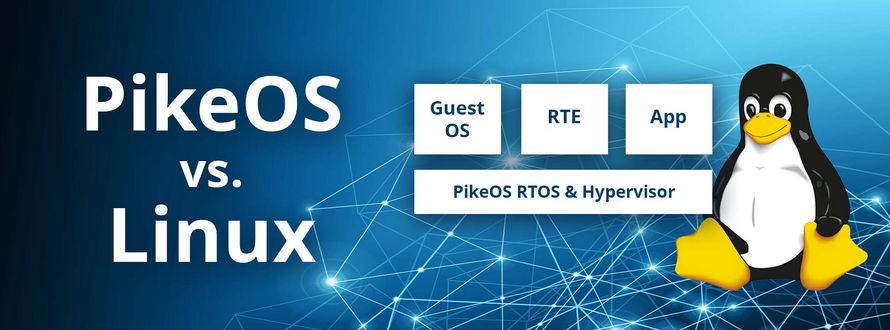In the world of embedded systems, two operating system paradigms often clash: General-purpose operating systems like Linux and real-time operating systems (RTOS) like PikeOS. While both serve the purpose of managing hardware resources and running applications, their underlying philosophies and target use cases differ significantly. Let's dive deeper into the key technological distinctions between PikeOS and a typical Linux distribution, highlighting the benefits each brings to its respective domain.
Linux: The General-Purpose Powerhouse
Linux, with its open-source nature and massive community support, has become ubiquitous. Its strength lies in its versatility and rich feature set.
A typical Linux distribution provides:
- General-Purpose Functionality: From web browsing to complex data processing, Linux excels in tasks demanding a wide range of applications and connectivity options
- Extensive Software Ecosystem: A vast library of open-source software, drivers, and tools makes development on Linux faster and often more cost-effective for general applications
- Hardware Abstraction: Linux provides a robust abstraction layer, allowing applications to run on a wide variety of hardware platforms with minimal porting effort
- Dynamic Environment: Linux is designed for dynamic environments, where applications can be loaded and unloaded at runtime, and system configurations can be changed on the fly
PikeOS: The Safety and Real-Time Champion
PikeOS, developed by SYSGO, takes a different approach. It's a hard real-time operating system specifically designed for Safety-critical and embedded applications.
Its key features include:
- Partitioning: PikeOS employs a strict partitioning architecture, isolating applications and system components from each other. This ensures that a failure in one partition cannot affect others, a crucial requirement in Safety-critical systems
- Real-Time Determinism: PikeOS guarantees predictable timing behavior. Tasks are assigned priorities, and the scheduler ensures that high-priority tasks are executed within strict deadlines. This is essential for applications requiring precise timing control, like Industrial Automation or Aerospace systems.
- Safety Certification: PikeOS is designed and certified to meet stringent safety standards like DO-178B/C (Aerospace), IEC 61508 (Industrial Automation), EN 50128 (Railway) and ISO 26262 (Automotive). This simplifies the certification process for Safety-critical applications
- Limited Footprint: PikeOS is designed to be lean and efficient, minimizing its resource footprint and maximizing performance, particularly important in resource-constrained embedded systems
- Static Configuration: Unlike Linux, PikeOS typically operates with a static configuration defined at compile time. This predictability is vital for Safety-critical systems where dynamic changes are undesirable
Technological Differences: A closer Look
The core differences between PikeOS and Linux stem from their design goals. Here's a breakdown:
- Kernel Architecture: Linux uses a monolithic kernel, while PikeOS employs a microkernel architecture. The microkernel approach in PikeOS enhances isolation and Security of applications and even complete operating systems, such as ELinOS, Linus, Android, …
- Scheduling: Linux uses a complex scheduler optimized for general-purpose tasks. PikeOS utilizes a priority-based, preemptive scheduler designed for hard real-time requirements
- Memory Management: Linux's memory management is dynamic and complex. PikeOS focuses on static memory allocation and partitioning to ensure predictability and prevent memory-related errors
- Inter-Process Communication (IPC): Linux offers various IPC mechanisms. PikeOS provides secure and deterministic IPC mechanisms tailored for Safety-critical communication
Customer Benefits: Choosing the right Tool
The choice between PikeOS and Linux depends entirely on the application's requirements.
- Linux Benefits:
- Rapid prototyping and development due to readily available tools and libraries
- Cost-effectiveness for general-purpose applications
- Wide range of hardware support
- Excellent connectivity options
- PikeOS Benefits:
- Uncompromising Safety, Security and reliability for critical applications
- Simplified certification process for critical systems
- Guaranteed real-time performance
- Robust partitioning for fault isolation
- Ideal for resource-constrained embedded systems where determinism is paramount
In Conclusion
Linux shines in applications demanding versatility, rich features, and rapid development. PikeOS excels in Safety-critical and real-time systems where reliability, determinism, and certification are non-negotiable. Understanding these fundamental differences is crucial for selecting the right operating system for your embedded project. Choosing the wrong OS can lead to project delays, cost overruns, and, in Safety-critical applications, potentially catastrophic consequences.

